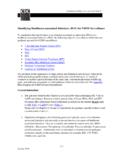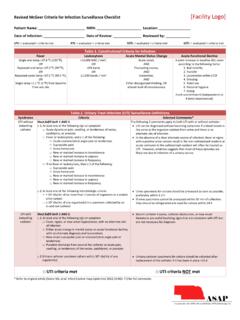Transcription of Surveillance Camera Code of Practice - GOV.UK
1 Surveillance Camera code of PracticeJune 2013 Surveillance Camera code of PracticePresented to Parliament Pursuant to Section 30 (1) (a) of theProtection of Freedoms Act 2012 June 2013 London: The Stationery Office Crown copyright 2013 You may re-use this information (excluding logos) free of charge in any format or medium, under the terms of the Open Government Licence. To view this licence, visit or e-mail: Where we have identified any third party copyright information you will need to obtain permission from the copyright holders concerned. Any enquiries regarding this publication should be sent to us at: Police Transparency Unit,6th Floor FRY Building,2 Marsham Street,London, SW1P 4 DFISBN: 9780108512421 Printed in the UK by The Stationery Office Limitedon behalf of the Controller of Her Majesty s Stationery OfficeID 562646 06/13 Printed on paper containing 75% recycled fibre content Introduction ..42. Overview and Guiding Principles.
2 93. The development or use of Surveillance Camera systems ..124. The use or processing of images or other information obtained by virtue of such systems 1 65. Surveillance Camera Commissioner ..224 Surveillance Camera code of Practice pursuant to the Protection of Freedoms Act 2012 Chapter 1: In this code : 1998 Act means the Data Protection Act 1998. 2000 Act means the Regulation of Investigatory Powers Act 2000. 2012 Act means the Protection of Freedoms Act 2012. Overt Surveillance means any use of Surveillance for which authority does not fall under the 2000 Act. Public place has the meaning given by Section 16(b) of the Public Order Act 1986 and is taken to include any highway and any place to which at the material time the public or any section of the public has access, on payment or otherwise, as of right or by virtue of express or implied permission. Relevant authority has the meaning given by Section 33(5) of the 2012 Act.
3 Surveillance Camera systems has the meaning given by Section 29(6) of the 2012 Act and is taken to include: (a) closed circuit television (CCTV) or automatic number plate recognition (ANPR) systems; (b) any other systems for recording or viewing visual images for Surveillance purposes; (c) any systems for storing, receiving, transmitting, processing or checking the images or information obtained by (a) or (b); (d) any other systems associated with, or otherwise connected with (a), (b) or (c)1. System Operator - person or persons that take a decision to deploy a Surveillance Camera system, and/or are responsible for defining its purpose, and/or are responsible for the control of the use or processing of images or other information obtained by virtue of such system. System User person or persons who may be employed or contracted by the system operator who have access to live or recorded images or other information obtained by virtue of such system.
4 This code of Practice is issued by the Secretary of State under Section 30 of the 2012 Act. It provides guidance on the appropriate and effective use of Surveillance Camera systems by relevant authorities (as defined by section 33 of the 2012 Act) in England and Wales who must have regard to the code when exercising any functions to which the code relates. Other operators and users of Surveillance Camera systems in England and Wales are encouraged to adopt the code voluntarily. It is a significant step in the ongoing process of delivering the government s commitment to the further regulation of CCTV which it believes is a task that is best managed in gradual and incremental stages. As understanding and application of the code increases the government may consider including other bodies as relevant authorities who will have to have regard to the Excludes any Camera system with relevant type approval of a prescribed device under Section 20 of the Road Traffic Offenders Act 1988 used exclusively for enforcement purposes, which captures and retains an image only when the relevant offence is detected and with no capability to be used for any Surveillance purpose.
5 For example, for the enforcement of speeding of the Surveillance Camera systems are deployed extensively within England and Wales, and these systems form part of a complex landscape of ownership and operation. Where used appropriately, these systems are valuable tools which contribute to public safety and security and in protecting both people and property. The government is fully supportive of the use of overt Surveillance cameras in a public place whenever that use is: in pursuit of a legitimate aim; necessary to meet a pressing need2; proportionate; effective, and; compliant with any relevant legal obligations. The purpose of the code will be to ensure that individuals and wider communities have confidence that Surveillance cameras are deployed to protect and support them, rather than spy on them. The government considers that wherever overt Surveillance in public places is in pursuit of a legitimate aim and meets a pressing need, any such Surveillance should be characterised as Surveillance by consent, and such consent on the part of the community must be informed consent and not assumed by a system operator.
6 Surveillance by consent should be regarded as analogous to policing by consent. In the British model of policing, police officers are citizens in uniform. They exercise their powers to police their fellow citizens with the implicit consent of their fellow citizens. Policing by consent is the phrase used to describe this. It denotes that the legitimacy of policing in the eyes of the public is based upon a general consensus of support that follows from transparency about their powers, demonstrating integrity in exercising those powers and their accountability for doing In order to achieve this, the code sets out guiding principles that should apply to all Surveillance Camera systems in public places. These guiding principles are designed to provide a framework for operators and users of Surveillance Camera systems so that there is proportionality and transparency in their use of Surveillance , and systems are capable of providing good quality images and other information which are fit for purpose.
7 To support the practical application of these guiding principles by a system operator, the Surveillance Camera Commissioner will provide information and advice on appropriate and approved operational and technical standards for various aspects of Surveillance Camera systems and on appropriate and approved occupational and competency standards for persons using these systems or processing images and information obtained by these systems to supplement this code . This code has been developed to address concerns over the potential for abuse or misuse of Surveillance by the state in public places, with the activities of local authorities and the police the initial focus of regulation. However, the government fully recognises that many Surveillance Camera systems within public places are operated by the private sector, by the third sector or by other public authorities (for example, shops and shopping centres, sports grounds and other sports venues, schools, transport systems and hospitals).
8 Informed by advice from the Surveillance Camera Commissioner, the government will keep the code under review and may in due course consider adding others to the list of relevant authorities pursuant to section 33(5)(k) of the 2012 Act. 2 A public authority will be bound by the Human Rights Act 1998 and will therefore be required to demonstrate a pressing need when undertaking Surveillance as this may interfere with the qualified right to respect for private and family life provided under Article 8 of the European Charter of Human Rights. This is the case whether or not that public authority is a relevant authority. A system operator who is not a public authority should nevertheless satisfy themselves that any Surveillance is necessary and Camera code of Practice pursuant to the Protection of Freedoms Act 2012 Scope of Surveillance activity to which this code The code applies to the use of Surveillance Camera systems as defined in paragraph that operate in public places in England and Wales, regardless of whether or not there is any live viewing, or recording of images or information or associated Covert Surveillance by public authorities (as defined in Part II of the 2000 Act) is not covered by this code but is regulated by the 2000 Act.
9 Covert Surveillance in public places by those who do not fall within the 2000 Act (for example, the private operator of a Surveillance Camera system in a shopping centre) may be used as part of a specific investigation in exceptional and justifiable circumstances. Any such covert use of private systems by or on behalf of a public authority (with the authority s knowledge) immediately places such use within the bounds of the 2000 of the A relevant authority must follow a duty to have regard to the guidance in this code when, in exercising any of its functions, it considers that the future deployment or continued deployment of Surveillance Camera systems to observe public places may be appropriate. This can include the operation or use of any Surveillance Camera systems, or the use or processing of images or other information obtained by virtue of such systems. The duty to have regard to this code also applies when a relevant authority uses a third party to discharge relevant functions covered by this code and where it enters into partnership arrangements.
10 Contractual provisions agreed after this code comes into effect with such third party service providers or partners must ensure that contractors are obliged by the terms of the contract to have regard to the code when exercising functions to which the code relates. The duty to have regard does not extend to such third party service providers or partners unless they themselves are a relevant authority. When a relevant authority in England has civil parking enforcement functions under the Traffic Management Act 2004 or bus lane enforcement functions under the Transport Act 2000, and considers the use of Surveillance Camera systems in exercising those functions, it must have regard to the guidance in this code . The primary purpose of any Surveillance Camera system used as part of civil enforcement arrangements must be the safe and efficient operation of the road network by deterring motorists from contravening parking or road traffic restrictions.













